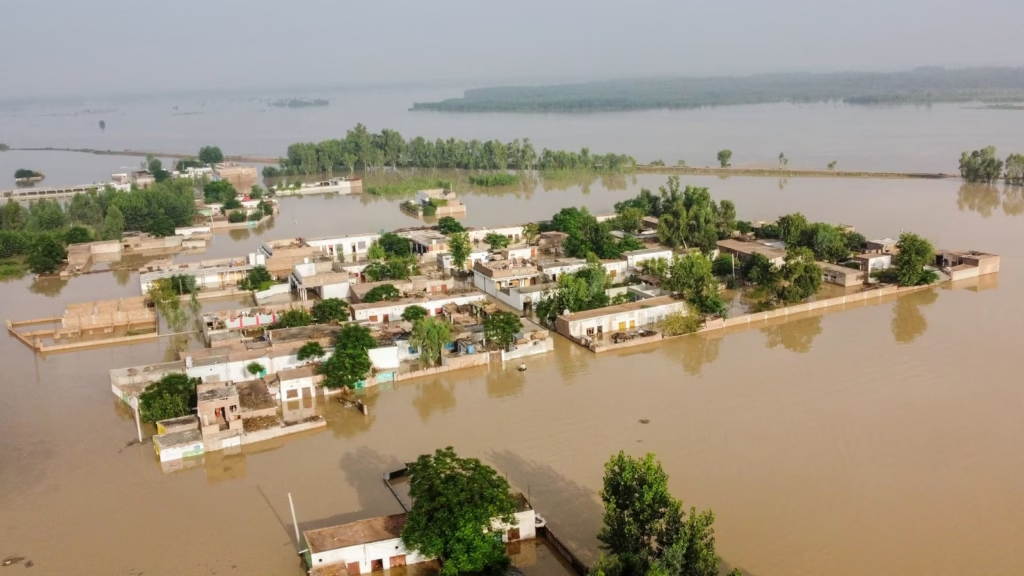The summer of 2025 has brought yet another catastrophe for Pakistan, as torrential monsoon rains and glacial melts combined to unleash some of the worst flooding in recent decades. Stretching from the northern mountains of Khyber Pakhtunkhwa (KP) to the agricultural heartlands of Punjab and the low-lying plains of Sindh, the floods have left devastation in their wake. Thousands of villages have been submerged, crops destroyed, and communities displaced. The tragedy of 2025 is not just a natural disaster, but also a reminder of how climate change, inadequate infrastructure, and cross-border water dynamics converge to create a humanitarian crisis.
The Beginning: Flash Floods in the North
The disaster began in July when intense rainfall hit KP province, triggering flash floods in districts such as Buner, Swat, and Dir. Temperatures in Gilgit-Baltistan soared to nearly 48.5°C, accelerating glacier melt and creating glacial lake outburst floods (GLOFs). These sudden torrents of water swept through valleys, destroying homes, roads, and bridges. More than 320 people died in KP alone, with over 200 fatalities reported in Buner district. The sheer force of the flash floods also trapped tourists, disrupted communication, and crippled rescue operations. Tragically, a relief helicopter crashed during a mission, killing five rescue personnel and underscoring the immense risks faced by first responders.
The Riverine Disaster: Punjab and Sindh Drown
As the floodwaters made their way south, Pakistan’s breadbasket—Punjab—became the next casualty. Heavy rains coincided with overflowing rivers, particularly the Sutlej and Ravi, causing massive inundations. Nearly 3,900 villages were submerged, forcing the evacuation of around one million people. Farmers, who form the backbone of Pakistan’s economy, were left watching helplessly as their standing crops of wheat, rice, and sugarcane disappeared under muddy waters. Estimates suggest that Punjab may have lost nearly 30% of its wheat stocks, raising alarms about food insecurity and possible shortages in the coming months.
Sindh, downstream of Punjab, also braced for disaster. The provincial government evacuated over 100,000 residents in anticipation of a flood surge exacerbated by dam releases across the border in India. As waters entered low-lying districts, entire communities were cut off, livestock perished, and disease outbreaks began to emerge in temporary shelters.
Cross-Border Water Pressures
The floods highlighted once again the transboundary nature of water management in South Asia. Indian dam releases, especially during peak monsoon flows, intensified the crisis in Punjab and Sindh. While such releases are often justified as safety measures for upstream infrastructure, they add to Pakistan’s burden of managing sudden inflows. Calls have resurfaced for diplomatic dialogue under the Indus Waters Treaty to better coordinate flood management and prevent avoidable tragedies.

Government Response and Relief Efforts
Pakistan’s National Disaster Management Authority (NDMA) released over ₨1.3 billion to support relief operations. They promoted the use of their flood warning mobile app, claiming a 92% accuracy rate in predictions. Early warning systems did help save lives, but in many rural areas, alerts did not reach vulnerable populations due to poor connectivity. Prime Minister Shehbaz Sharif has since directed officials to prepare a Climate Resilience Action Plan for 2026, aimed at building long-term defenses against disasters like these.
Rescue operations, however, have been fraught with challenges. Flood-hit areas suffered from shortages of boats, fuel, and medical supplies. International aid agencies, recalling the devastation of 2022, have stepped in once more with food parcels, temporary shelters, and health services. Still, the sheer scale of displacement—hundreds of thousands of families—has left authorities overwhelmed.
The Human Cost
Behind every statistic is a human story. Families have lost homes built over generations. Children have seen their schools washed away, and farmers face the heartbreak of watching years of effort vanish overnight. In Sindh, women and children now live in cramped tents, where lack of clean drinking water has led to outbreaks of diarrhea and skin infections. The psychological toll of repeated disasters, from the mega floods of 2022 to the current crisis, is immense. Communities express a sense of despair, but also resilience, as neighbors share what little food and resources they have.
Pakistan’s 2025 Monsoon Floods: From Flash Floods to Riverine Disasters
Climate Change: A Root Cause
Climate experts point to the increasingly erratic monsoon patterns, rising temperatures, and rapid glacial melt as drivers of Pakistan’s recurring flood crises. Pakistan contributes less than 1% to global greenhouse gas emissions, yet it remains one of the most vulnerable nations to climate change. The floods of 2025 once again emphasize the urgent need for climate adaptation strategies, including better urban planning, stronger embankments, improved drainage systems, and community awareness campaigns.
Learning from the Past, Preparing for the Future
The parallels with the 2022 floods are striking. In both cases, millions were displaced, food security was threatened, and billions in damages were incurred. Yet little progress has been made in flood-resilient infrastructure or sustainable water management. If Pakistan does not invest in long-term planning, such as river zoning, early evacuation routes, and climate-smart agriculture, the cycle of destruction will continue.
Conclusion
Pakistan’s 2025 monsoon floods are a stark reminder of nature’s power and humanity’s vulnerability. They are not isolated events, but part of a larger pattern fueled by climate change and inadequate disaster management. The country must balance immediate relief with long-term resilience, ensuring that communities are not just saved today but safeguarded for tomorrow. For the world, these floods are yet another wake-up call that climate change is not a distant threat—it is already here, devastating lives and livelihoods in places like Pakistan.
Tags:
- Pakistan Floods 2025
- Monsoon Disaster Pakistan
- Climate Change in South Asia
- Punjab and Sindh Flood Crisis
- Flash Floods in Khyber Pakhtunkhwa
- Pakistan Food Security 2025
- NDMA and Disaster Management
- Glacial Melt and Flooding
- Indus Waters Treaty Issues
- Humanitarian Crisis in Pakistan



